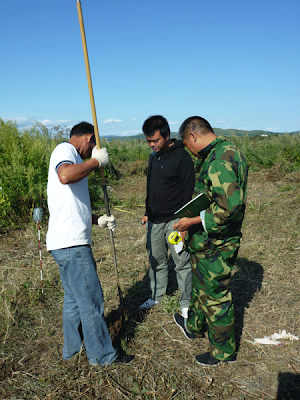The Kraskino city-site is located in Kraskino Township in Russia’s southern Primorsky Territory, near the mouth of the Chukanov River, known as ancient Longyuanfu, the east capital of Bohai Kingdom. Since 1980, Institute of Far East History, Archaeology and Nationality Studies, the Far East Branch of Russia Science Academy has conducted years of survey and excavations. In recent years scholars from Japan and Korea have also attended excavations to the city walls and the inside remains.
According to the agreement with its Russia partner, Institute of Far East History, Archaeology and Nationality Studies, the Far East Branch of Russia Science Academy, Jilin Provincial Institute of Archaeology and Cultural Relic has conducted 20-day’s survey to the city-site since September 2011. Before, the Russia side had explored it wholly with electromagnetic sensing techniques, which provided reference for this excavation. The north (Area I) and southeast (Area II) parts of the site were selected to be further explored, with an drilling area totaled 4000 square meter.
The drilling exploration yielded 7 building remains, 4 serious-destroyed or unclear wall segments, and 2 ash pits from an earlier period.
Remain 1 at the southwest of Area I is a rectangular stone-walled structure built on the ground, measuring 20 m long from east to west and 11 m wide from south to north, orientation 224°. There are three probable column base remains in the middle of the area, which are arranged in a line parallel with the wall. Each of them is built with irregular stones, measuring 1 m wide and 1.5 m long.
Remain 3 in the middle of Area I is a rectangular structure built on the ground, with the west wall measuring 4.5 m long and 0.5 m wide, the remaining north wall 8.1 m long and 0.5 m wide, the remaining south wall 1.8 m long and 0.5 m wide, orientation 211°.
Remain 5 in the north of Area I is another rectangular structure built on the ground, measuring 9 m from west to east and 6.5 m from south to north and 0.5 thick.
The ash pit is in a roughly round shape, with the fillings containing large amount of charcoal debris and a few of reddish scorched earthen grains. No other artifacts have been found.
All artifacts are unearthed from drilling, which are mostly potteries including tiles and containers. There are 8 pieces of tiles, which are all plate tiles with undecorated convex surface and fabric-patterned concave surface, showing a typical characteristic of the Bohai Kingdom period. The tile’s earthen body, measuring 1.4-1.8 cm in thickness, is mixed with fine sands. Their surfaces are mostly in gray, some are in red, and a very few are in black. There are more than 20 pieces of ceramics, mostly made of fine earth and some mixed with fine sands. Those with a black surface are in the majority, gray and reddish brown potteries take the second. On some wares distinct traces from wheel-making could be seen. Judged from the rims, bottoms and shapes of the body, they originally could belong to large objects with a flat bottom like pots, urns and jars. In additional, other findings include ceramic rings, ceramic cake models, tricolor fragments and animal bones.
Commissioned by the Russia side, Jilin archaeologists have drilling-explored the adjacent region of an uncovered tomb from the Bohai period, locating at 300 m west of the city-site. A stone-built tomb from the Bohai period has been found, which is in a nearly rectangular shape and built with irregular stones. The tomb’s walls are about 0.3-0.4 m wide and 0.6 m high. The tomb pit measures 4.7 m long from south to north and 2.6 m wide from west to east. The opening of the tomb is 0.5 m deep and the bottom is 1.2 m deep under the surface. The tomb chamber is 3.6 m long from south to north, 1.8 m wide from west to east and 0.6 m deep.
The Kraskino city-site is the only known Bohai Kingdom city that has been excavated for years and is confirmed by the academic circle. But limited by the working progress the overall plane and structure of the site are unfortunately kept unclear. The drilling exploration provides abundant underground information, which is important for studying the city-site, and also provides us a possible way for resolving problems concerning the Bohai cities’ structures. (Translator: Tong Tao)
Source: China Archeology/ Institute of Archeology/ Chinese Academy of Social Sciences

No comments:
Post a Comment